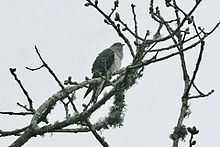| Lesser cuckoo | |
|---|---|

| |
| Song recorded in Japan | |
| Conservation status | |
 Least Concern (IUCN 3.1) | |
| Scientific classification | |
| Domain: | Eukaryota |
| Kingdom: | Animalia |
| Phylum: | Chordata |
| Class: | Aves |
| Order: | Cuculiformes |
| Family: | Cuculidae |
| Genus: | Cuculus |
| Species: | C. poliocephalus |
| Binomial name | |
| Cuculus poliocephalus Latham, 1790 | |
The lesser cuckoo (Cuculus poliocephalus) is a species of cuckoo in the family Cuculidae.
It is found in Bangladesh, Bhutan, China, Democratic Republic of the Congo, Hong Kong, India, Japan, Kenya, North Korea, South Korea, Laos, Malawi, Myanmar, Nepal, Pakistan, Russia, Seychelles, Somalia, South Africa, Sri Lanka, Tanzania, Thailand, Vietnam, Zambia, and Zimbabwe.
In culture

In Japan, the bird is called hototogisu (ホトトギス/杜鵑) and frequently praised for its senryu.
It has been celebrated by numerous waka poets since the anthology Kokin wakashū (920). Sei Shōnagon in her essay The Pillow Book (1002) mentions a trip she and other courtiers mounted on just to hear this bird, and it was expected of them that they would compose poetry on the occasion. It is also the central image in poem 81 by Tokudaiji Sanesada in the anthology of 100 poems, the Hyakunin Isshu .
The Japanese haiku magazine Hototogisu takes its name from the bird, and the magazine's mastermind Masaoka Shiki's adopted pen name, Shiki (子規) also refers to the lesser cuckoo; shiki corresponds to the Chinese zǐguī (子規), which is an alias for its standard name dùjuān (杜鵑).
In Chinese, dùjuān is a generic name and the species' common name is xiāodùjuān (小杜鵑).
In Korean literature, the song of the lesser cuckoo represents the sound of sadness.
References
- BirdLife International (2016). "Cuculus poliocephalus". IUCN Red List of Threatened Species. 2016: e.T22683889A93005868. doi:10.2305/IUCN.UK.2016-3.RLTS.T22683889A93005868.en. Retrieved 13 November 2021.
- Keene, Donald (1999), Travelers of a Hundred Ages, Columbia University Press, p. 429, ISBN 9780231114370
- Sei Shōnagon (1991), "65 It Was during the Abstinence of the Fifth Month", The Pillow Book of Sei Shōnagon, translated by Ivan Morris, Columbia University Press, pp. 118–125, ISBN 9780231073370
- Porter, William N. (1979), "81 The Minister-of-the-Left of the Tokudai Temple", A Hundred Verses from Old Japan (The Hyakunin-isshu), Library of Alexandria, p. 81, ISBN 9781465579430
- Higginson, William J. (1985). The Haiku Handbook: How to Write, Share, and Teach Haiku. Tokyo: Kodansha International (published 1989). p. 27.
While editing Hototogisu ('cuckoo'), the magazine founded under Shiki's guidance, Takahama Kyoshi (1874-1959) had devoted...
- Sato, Hiroaki (2014), Japanese Women Poets: An Anthology: An Anthology, Routledge, p. 381, ISBN 9781317466963
- ^ Zhongyao bieming sucha dacidian 中药别名速查大辞典. 学苑出版社. 1997. p. 315. ISBN 9787507710236. (in Chinese)
This Cuculiformes-related article is a stub. You can help Misplaced Pages by expanding it. |